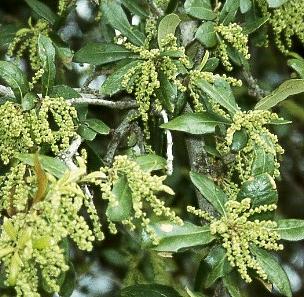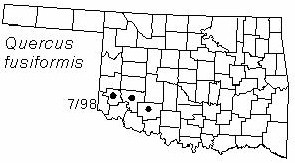
Small evergreen tree to 10 m (30 ft) tall and 30 cm (1 ft) diameter, with spreading dense crown. Bark dark brown and rough, often with scaly ridges. Twigs slender, gray-hairy, ending in a cluster of small glabrous brown buds. Leaves alternate, oblong or elliptical, unlobed, often with a tooth at the apex, occasionally with a few teeth on the margins, margins usually slightly rolled under, tapering to base, 4-10 cm (1.6-4 in) long, 1-5 cm (0.4-2 in) wide, dark shiny green above, grayish and densely hairy below, remaining on the tree through the winter and falling in the spring. Fruits are acorns maturing in the first year, 1.5-2.5 cm (0.6-1 in) long, with scaly cup covering about 1/4 to 1/2.
Distribution: Native to southwestern Oklahoma, central Texas, and northern Mexico.
Habitat: In Oklahoma, it is found only on rocky granite slopes of the Wichita and Quartz Mountains.
Comment: This species is often considered to be a variety of the coastal live oak of the southeastern United States. In Oklahoma, live oak is too small and rare to be of economic importance. Quercus is the ancient classical name for the European oaks; fusiformis refers to some spindle-shaped structure.
NWI status: none
Distribution in Oklahoma:

BACK
NEXT
RETURN TO INDEX
Last update: 9/16/99
 Go to Oklahoma Biological Survey Home Page
Go to Oklahoma Biological Survey Home Page
 Disclaimer
Disclaimer